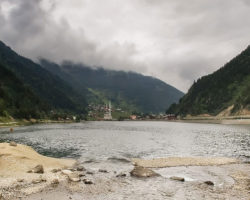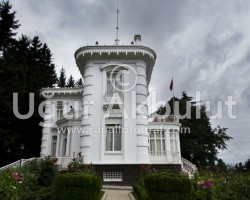[kml_flashembed publishmethod=”static” fversion=”8.0.0″ movie=”https://www.sanalfotograf.com/ugurakbulut/trabzon-ayasofya-muzesi-5.swf” width=”100%” height=”556″ targetclass=”flashmovie” allowfullscreen=”true”]
[/kml_flashembed]
| Trabzon Ayasofya Müzesi, Trabzon’un Yenimahalle semtinde bulunan tarihi müzedir.İstanbul’un Latinler tarafından isgal edilmesinden sonra kaçan ve Trabzon’da 1204 yılında yeni bir devlet kuran Komnenos ailesinden Kral I.Manuel (1238-1263) tarafından 1250-1260 yılları arasında yaptırılan ve bir manastır kilisesi olan Ayasofya adı “Kutsal Bilgelik” anlamına gelir.Geç Bizans Kiliselerinin en güzel örneklerinden biri olan yapı, kare-haç planlı olup, yüksek bir kubbeye sahiptir. Kuzey, batı ve güneyinde revaklı üç kirişi bulunmaktadır. Yapı ana kubbenin üzerine değişik tonozlarla örtülmüş ve çatıya farklı yükseltiler verilerek kiremitle örtülmüştür.
Üstün bir işçiliğin görüldüğü taş plastiklerde Hristiyan sanatının yanı sıra Selçuklu Dönemi İslam sanatının da etkileri görülmektedir. Kuzey ve batıdaki revak cephelerinde görülen geometrik geçmeli bezemeleri içeren madalyonlarla, batı cephesinde görülen mukarnaslı nişler Selçuklu taş işlemelerindeki özellikleri taşımaktadır. Binanın en görkemli cephesi güneyidir. Burada Adem’le Havva’nın yaratılışı kabartma olarak bir friz halinde anlatılmıştır. Güney cephesindeki kemerin kilittaşı üzerinde Trabzon’da 257 yıl hüküm süren Komnenosların sembolü olan tekbaşlı kartal motifi bulunmaktadır. Kubbede ana tasvir İsa’nın tanrısal yönünü aksettiren pantacrator İsa’dır. Bunun altında bir kitabe kuşağı, daha altta ise melekler frizi bulunur. Pencere aralarında oniki havari tasvir edilmiştir. Pandantiflerde değişik kompozisyonlar yer almaktadır. İsa’nın doğumu, vaftizi, çarmıha gerilişi, kıyamet günü gibi sahneler betimlenmiştir. Fatih Sultan Mehmed’in 1461 yılında Trabzon’u fethiyle camiye çevrilmiş ve vakıf eser olmuştur. 1868 yılında Bursa’lı Rıza Efendi’nin teşvikleriyle yeni baştan onarılmıştır. I. Dünya Savaşı yıllarında Ruslar tarafından işgal edilen Ayasofya, askeri karargâh, hastane, depo ve savaştan sonra yine cami olarak kullanılmıştır. 1958-1962 yılları arasında Edinburgh Üniversitesi ve Vakıflar Genel Müdürlüğü işbirliği ile restore edilerek, 1964 yılında müzeye çevrilmiştir. “Trabzon Ayasofya Müzesi.” Wikipedia, Özgür Ansiklopedi. 31 Ekim 2009, 23:20 UTC. 17 Kas 2009, 00:23 <http://tr.wikipedia.org/w/index.php?title=Trabzon_Ayasofya_M%C3%BCzesi&oldid=6661077>. ———————————————————————————————————————————————————————— ENGLISH The Hagia Sophia (Greek: Ἁγία Σοφία, meaning “Holy Wisdom”; Turkish: Ayasofya), now the Hagia Sophia Museum, is a former church and mosque located in the city of Trabzon in the north-eastern part of Turkey. It dates back to the 13th century when Trabzon was the capital of the Empire of Trebizond. It is located near the seashore and 2 miles west of the Comnenon fortress. It is one of a few Byzantine sites still existent in the area. The Hagia Sophia church was built in Trebizond during the reign of Manuel I between 1238 and 1263. After Mehmed II conquered the city in 1461 the church was converted into a mosque. During the brief period of the city in Russia’s hands during World War I, the site was used by the Russian military as a makeshift hospital and depot. Afterwards it was put back into use as a mosque, until 1964 when it was turned into a museum which it remains to this day. From 1958-64 the site was restored with the help of Edinburgh University and the General Directorate of Foundations. The Hagia Sophia is an important monument of the late Byzantine architecture, being characterised by a high central dome and the four large column arches supporting the weight of the dome and ceiling. The church was built in cross-in-square plan. It has the shape of a cross and is 22 metres long, 11.6 metres wide and 12.7 metres tall. . The late 13th-century frescos, revealed during the most recent restoration, illustrate the New Testament themes, while external stone ornamenting is in keeping with local traditions of Islamic art. In the center of the floor of the church there is an exceptional Opus Sectile pavement with many beautiful multicolored stones. The author Texier visited Trebizond in 1836 and in his book “Byzantine Architecture” London 1864 he says…. “The beautiful mosaic (Shuld be Opus Sectile)floor at the center of the church can be considered one of the most extraordinary examples of the Byzantine marble mosaics which has survived until the present, perhaps the finest now in existence.” The historian Finley (1850) described the mosaic floor fairly fully in his manuscript journal. He says… “The pavement under the dome is richly worked in porphyry serpentine colored and gilt glass and most firmly cemented. This is true Byzantine style though better executed than usual” West of the church and 24 meters in distance there is a tower 40 meters in height. It was built in 1427. Many originally believed that this was the steeple of the church. But it is well known that at the time there were no bells in Trebizond. There were bells only at Hagia Sophia in Constantinople. In Trebizond they used to strike the wooden semantra to mark the most important points of the divine liturgy. From the ruins of the Hagia Sophia monastery it is recognized that the tower was a part of the monastery. The inside of the tower was full of excellent frescoes. Wikipedia contributors. “Hagia Sophia, Trabzon.” Wikipedia, The Free Encyclopedia. Wikipedia, The Free Encyclopedia, 25 Apr. 2010. Web. 7 Jul. 2010. |
|




Henüz yorum yapılmamış